Giacinto Gimignani, who came from a famous family of painters in Pistoia, was probably trained by his father, Alessio Gimignani. He was documented in Rome from 1630 and worked there under Pietro da Cortona for the Barberini family from 1632. He subsequently joined the movement against the exuberance of the style of Pietro d Cortona, which was led by Andrea Sacchi. His earliest known work is a frescoed (1632) of the Rest on the Flight to Egypt in the chapel of the Palazzo Barberini.
Amelia
Giacinto Gimignani had a number of links with Amelia:
-
✴two of his daughters were nuns at San Magno;
-
✴his son belonged to the Collegio dei Padri Somaschi at Sant’ Angelo (see below); and
-
✴he had links with Bishop Gaudenzio Poli (1643-79).
St Liborius (1675)
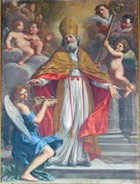
Trinity with saints (17th century)
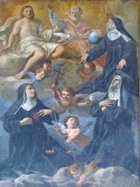
Works from Sant’ Angelo
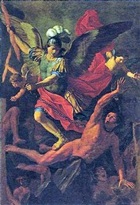
-
✴Christ on the Cross (17th century)
-
This altarpiece, which was documented in the sacristy of the church, was transferred to the Civic Collection but subsequently lost.
-
✴St Michael defeating the Devil (1677)
-
This altarpiece from the church, which is signed and dated by inscription, is now in the Pinacoteca (illustrated here).
Montefalco
SS Bartholomew and John the Evangelist (17th century)
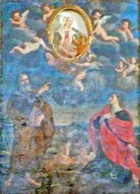
Orvieto
Education of the Virgin (ca. 1650)
This panel on the 1st altar on the right of the church of San Bernardino is attributed to Giacinto Gimignani. The arms of the Conti di Marsciano appear at the bottom right. The commission might have arisen because Cardinal Fausto Poli, who was a collector of works by Giacinto Gimignani, was Bishop of Orvieto in 1645-56. The upper part of the panel was pained at a later date, which suggests that this was not its original location.
Perugia
Panels in San Pietro
The following panels are San Pietro:
Miracle of the Column (1677)
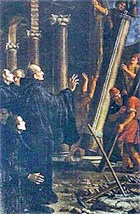
Scenes from the Life of St Benedict (1679)
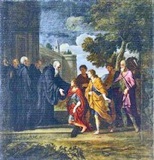
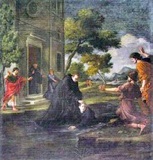
These panels by Giacinto Gimignani in the left aisle depict:
-
✴St Benedict welcoming SS Maurus and Placidus to his monastery at Subiaco; and
-
✴St Benedict saving St Placidus from drowning.



